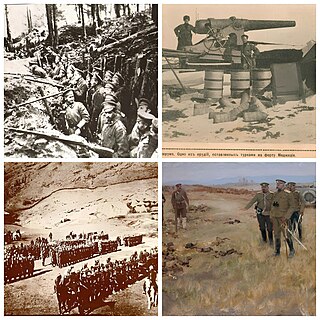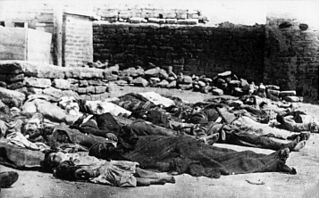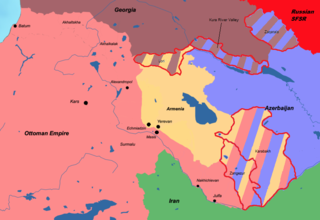
The Democratic Republic of Georgia was the first modern establishment of a republic of Georgia, which existed from May 1918 to February 1921. Recognized by all major European powers of the time, DRG was created in the wake of the Russian Revolution of 1917, which led to the collapse of the Russian Empire and allowed territories formerly under Russia's rule to assert independence. In contrast to Bolshevik Russia, DRG was governed by a moderate, multi-party political system led by the Georgian Social Democratic Party (Mensheviks).

The Transcaucasian Democratic Federative Republic was a short-lived state in the Caucasus that included most of the territory of the present-day Armenia, Azerbaijan and Georgia, as well as parts of Russia and Turkey. The state lasted only for a month before Georgia declared independence, followed shortly after by Armenia and Azerbaijan.

The Armeno-Georgian War was a short border dispute that was fought in December 1918 between the newly independent Democratic Republic of Georgia and the First Republic of Armenia, largely over the control of former districts of the Tiflis Governorate, in Borchaly (Lori) and Akhalkalaki.

The Armistice of Mudros was signed on 30 October 1918 and took effect at noon the next day, the Armistice of Mudros ended hostilities in the Middle Eastern theatre between the Ottoman Empire and the Allies of World War I. It was signed by the Ottoman Minister of Marine Affairs Rauf Bey and British Admiral Somerset Arthur Gough-Calthorpe, on board HMS Agamemnon in Moudros harbor on the Greek island of Lemnos.

The Azerbaijan Democratic Republic, also known as the Azerbaijan People's Republic, was the first secular democratic republic in the Turkic and Muslim worlds. The ADR was founded by the Azerbaijani National Council in Tiflis on 28 May 1918 after the collapse of the Transcaucasian Democratic Federative Republic, and ceased to exist on April 28, 1920. Its established borders were with Russia to the north, the Democratic Republic of Georgia to the north-west, the Republic of Armenia to the west, and Iran to the south. It had a population of around 3 million. Ganja was the temporary capital of the Republic as Baku was under Bolshevik control. The name of "Azerbaijan" which the leading Musavat party adopted, for political reasons, was, prior to the establishment of the Azerbaijan Democratic Republic in 1918, exclusively used to identify the adjacent region of contemporary northwestern Iran.

The Caucasus campaign comprised armed conflicts between the Russian Empire and the Ottoman Empire, later including Armenia, Azerbaijan, Georgia, the Mountainous Republic of the Northern Caucasus, the German Empire, the Central Caspian Dictatorship, and the British Empire, as part of the Middle Eastern theatre during World War I. The Caucasus campaign extended from the South Caucasus to the Armenian Highlands region, reaching as far as Trabzon, Bitlis, Mush and Van. The land warfare was accompanied by naval engagements in the Black Sea.

The Islamic Army of the Caucasus was a military unit of the Ottoman Empire formed on July 10, 1918. The Ottoman Minister of War, Enver Pasha, ordered its establishment, and it played a major role during the Caucasus Campaign of World War I.

The March Days or March Events was a period of inter-ethnic strife and clashes which took place between 30 March – 2 April 1918 in the city of Baku and adjacent areas of the Baku Governorate of the Transcaucasian Commissariat.

The Treaty of Batum was signed in Batum on 4 June 1918, between the Ottoman Empire and the three Transcaucasian states: the First Republic of Armenia, the Azerbaijan Democratic Republic and the Democratic Republic of Georgia. It was the first treaty of the First Republic of Armenia and the Azerbaijan Democratic Republic and had 14 articles.

The occupation of Western Armenia by the Russian Empire during World War I began in 1915 and was formally ended by the Treaty of Brest-Litovsk. It was sometimes referred to as the Republic of Van by Armenians. Aram Manukian of the Armenian Revolutionary Federation was the de facto head until July 1915. It was briefly referred to as "Free Vaspurakan". After a setback beginning in August 1915, it was re-established in June 1916. The region was allocated to Russia by the Allies in April 1916 under the Sazonov–Paléologue Agreement.

The Battle of Baku took place in August and September 1918 between the Ottoman–Azerbaijani coalition forces led by Nuri Pasha and Bolshevik–ARF Baku Soviet forces, later succeeded by the British–Armenian–White Russian forces led by Lionel Dunsterville and saw Soviet Russia briefly re-enter the war. The battle took place during World War I, was a conclusive part of the Caucasus Campaign, but a beginning of the Armenian–Azerbaijani War.
The Treaty of Poti was a bilateral agreement between the German Empire and the Democratic Republic of Georgia in which the latter accepted German protection and recognition. The agreement was signed, on 28 May 1918, by General Otto von Lossow for Germany and by Foreign Minister Akaki Chkhenkeli for Georgia. Concluded at the Georgian Black Sea port of Poti, the treaty came only two days after Georgia proclaimed independence, becoming the newly independent republic's first-ever international treaty.

Christophor Araratov, also known as Khachatur Araratian and Christapor Araratian, was an Armenian career officer of the Russian Imperial Army. He was promoted to the rank of Major General of the Armenian army during its fight for independence during and after World War I. Araratov participated in the 1918 battles of Sardarapat and Karakilisa against Turkish invaders.
The Armistice of Erzincan was an agreement to suspend hostilities during World War I signed by the Ottoman Empire and Transcaucasian Commissariat in Erzincan on 18 December 1917. The armistice brought temporary peace to the Caucasian and Persian Fronts until 12 February, when the fighting was resumed.

The Trebizond Peace Conference was a conference held between 14 March and 13 April 1918 in Trebizond between the Ottoman Empire and a delegation of the Transcaucasian Diet and government. The opening session was on 14 March 1918. The representatives were Rear-Admiral Hüseyin Rauf Bey for the Ottoman Empire, and Akaki Chkhenkeli, Khalil bey Khasmammadov, Alexander Khatisian etc. as the Transcaucasian delegation.

The Transcaucasian Seim was a representative and legislative body of state power in the Transcaucasus, convened by the Transcaucasian Commissariat in Tiflis on 23 February 1918. Its members consisted of Russian Constituent Assembly deputies elected in Transcaucasia, as well as representatives of the various political parties of Transcaucasia. Its chairman was Nikolay Chkheidze of the Social Democratic Party of Georgia.

The Batum oblast was a province (oblast) of the Caucasus Viceroyalty of the Russian Empire, with the Black Sea port of Batum as its administrative center. The Batum oblast roughly corresponded to most of present-day southwestern Georgia, and part of the Artvin Province of Turkey.

The Ottoman Empire came into World War I as one of the Central Powers. The Ottoman Empire entered the war by carrying out a small surprise attack on the Black Sea coast of Russia on 29 October 1914, with Russia responding by declaring war on 2 November 1914. Ottoman forces fought the Entente in the Balkans and the Middle Eastern theatre of World War I. The Ottoman Empire's defeat in the war in 1918 was crucial in the eventual dissolution of the empire in 1922.
The Greek Caucasus Division, was a division of the Russian Army composed of ethnic Greeks from the Caucasus and Pontus regions during World War I. Formed in the closing stages of the Caucasus Campaign, it protected the local Greek population from attacks by Muslim militias and the Ottoman army. It was disbanded a year later as a result of the Treaty of Poti.

The battle of Binagadi lasted from August 26, 1918 to September 1, 1918.During the battle, Azerbaijani troops captured hills 311 and 364 near the Binagadi.This battle is part of Battle of Baku
















